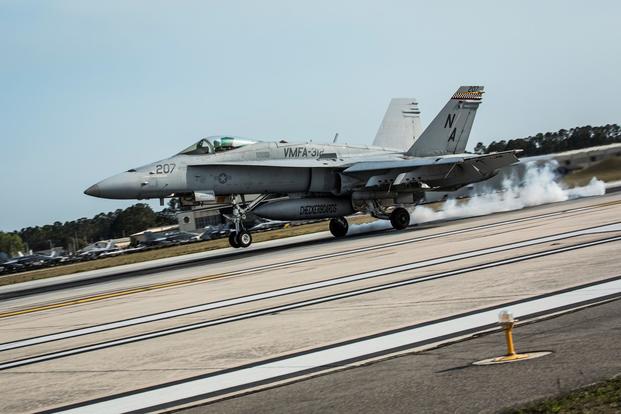The Marine Corps is set to offer retention bonuses for aviators for the first time since 2011 as its F-35B Joint Strike Fighters enter the fleet in greater numbers.
As some of the military services find themselves hard-pressed to compete with the high-paying airline industry to keep seasoned pilots in the force, top brass are looking for new ways to leverage bonuses, as well as more career flexibility, as incentives.
In a hearing before the House Armed Services subcommittee on military personnel, Lt. Gen. Mark Brilakis, deputy commandant for Marine Corps Manpower and Reserve Affairs, said that while retention has not been an overall problem for Marine Corps aviation, the multi-year drawdown from 202,000 troops to the current end strength of 182,000 left the aviation community somewhat imbalanced and short on experienced company-grade officers.
"The F-35 and V-22 [Osprey] are currently growing communities, and we don't want to be caught short in those aviation communities," Brilakis said. "We have fewer company-grade officers than we really need to be flying in our tactical squadrons. So we want to be sure that we have the opportunity and leverage to maintain those young officers as they come out of their required commitment to us and capture them for that extra bit of time."
Commandant Gen. Robert Neller is submitting a request to the secretary of defense and the secretary of the Navy to offer retention bonuses in three communities: F/A-18 Hornet pilots as well as F-35s and V-22s, Brilakis said.
While F-35s are new and the V-22 program continues to grow, the legacy Hornet platform has been most challenged in recent years, with pilots struggling to reach monthly flight-hour goals as aging aircraft are increasingly unavailable due to needed maintenance and spare parts.
The bonuses, requested to begin in fiscal 2018, which begins Oct. 1, are likely to be a temporary offer. Brilakis said the Marine Corps has made up for a dip in pilot retention amid the drawdown with a robust recruitment program that promises to flood the junior aviator ranks in coming years.
"I've got just over 500 officers still in the training pipeline, more than I need," he said.
On the enlisted side, the Marine Corps is offering new monetary enticements for those with experience and talent.
In addition to retention bonuses already paid to enlisted maintainers, the service plans to add a "kicker" additional payment for Marines willing to re-enlist and commit to stay in their squadron for another 24 months maintaining their current capabilities, Brilakis said. He did not say how much the kicker payment would total, but said it would begin in the next fiscal year.
"More often than not, a Marine who re-enlists has a location option. He may want to go to recruiting duty or to the drill field because our Marines serve across the Marine Corps," Brilakis said.
"This bonus is going to take that hard-won experience at the senior sergeant, staff NCO level, and retain it in the squadron in certain numbers so they can train the next generation in those certification requirements," he said. "That's new for us."
While the Marine Corps is paying attention to financial incentives, Brilakis said a survey the Corps conducted about 18 months ago found competitive commercial pay did not feature in the top three reasons that persuaded Marines in the aviation community to leave. The first, he said, was the struggle to complete flight hours; after that came scarcity of parts; then the high operational tempo and tight deployment cycle for squadrons.
Brilakis said the Corps is open to using more tools, such as the service's career intermission program or partnerships with industry, to develop more ways to retain experienced pilots.
-- Hope Hodge Seck can be reached at hope.seck@military.com. Follow her on Twitter at @HopeSeck.




























